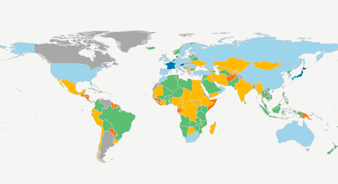Indicator 6.5.1 “Degree of integrated water resources management implementation (0-100)”
Target 6.5 aims to implement integrated water resources management (IWRM) at all levels – this page explains why and how to monitor progress towards this target.
The indicator at a glance
Indicator 6.5.1 tracks the degree of integrated water resources management (IWRM) implementation, by assessing the four key components of IWRM:
- Enabling environment.
- Institutions and participation.
- Management instruments.
- Financing.
It takes into account the various users and uses of water, with the aim of promoting positive social, economic and environmental impacts at all levels, including the transboundary level, where appropriate.
Data on 6.5.1 is collected through a questionnaire and responses are consolidated through consultations between relevant stakeholders, such as national and subnational line ministries and institutions involved in water resources management and other stakeholders such as NGOs, academia and business.
Available support
The United Nations Environment Programme (UNEP) is the custodian of indicator 6.5.1. For any enquiries about available support, please contact their helpdesk.
Guidance on data collection and reporting
- UNEP: Monitoring methodology including 6.5.1 survey instrument.
- UN-Water: Data collection process and timeline.
Online support
- UNEP: Helpdesk (email, phone, video conference).
- UNEP: IWRM Data Portal (methodology materials, previous data submissions, global maps and other information relating to 6.5.1 monitoring).
Face-to-face support
- National workshops in selected countries.
Data and progress reporting
- UN-Water: SDG 6 Data Portal.
- UNEP: 6.5.1 data including country reports and summaries (IWRM Data Portal).
- UNEP on behalf of UN-Water: 2018 Progress Report.
- UNEP on behalf of UN-Water: 2021 Progress Report (including infographics).
- UNEP on behalf of UN-Water: 2024 Progress Report (visual summary and video).

Why monitor IWRM?
IWRM monitoring calls for a participatory approach in which representatives from across sectors are brought together to discuss and validate data, paving the way for coordination and collaboration beyond monitoring.
